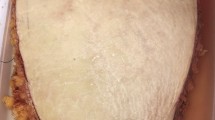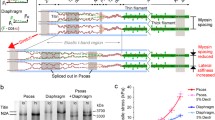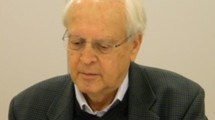Abstract
Striae distensae are characterized by linear, smooth bands of atrophic-appearing skin that are reddish at first and finally white. They are due to stretching of the skin, as in rapid weight gain, or mechanical stress, as in weight lifting. The pathogenesis of striae distensae is unknown but probably relates to changes in the fibroblast phenotype. In order to characterize striae distensae fibroblasts, alpha-smooth muscle actin expression and contractile forces were studied. Five healthy women with early erythematous striae and five healthy women with older striae were selected. Paired biopsies were taken from the center of lesional striae and adjacent normal skin. Fibroblasts were obtained by an explant technique and expanded in vitro in Dulbecco’s modified Eagle‘s medium. Contractile forces generated by fibroblasts in collagen lattices were measured with the Glasbox device developed in our laboratory. Alpha-smooth muscle actin expression was studied by immunofluorescence labeling of cells and by flow cytometry. Fibroblasts from early striae distensae were the richest cells in alpha-smooth muscle actin filaments and generated the highest contractile forces. Their peak contractile force was 26% greater than normal fibroblasts. There was a 150% higher level of alpha-smooth muscle actin content in fibroblasts from early striae distensae compared with fibroblasts from normal skin. In contrast, there was no significant difference in force generation between old striae fibroblasts and normal fibroblasts with cells expressing no alpha-smooth muscle actin. The contractile properties of fibroblasts from striae distensae varies depending on the stage of the disease. In early striae distensae, fibroblasts acquire a more contractile phenotype, corresponding to that of myofibroblasts.





Similar content being viewed by others
References
Armbruster V, Gharbi T, Viennet C, Humbert P (2004) Silicon grid devices for attachment of cultured fibroblast collagen lattices. Sensor Actuat A Phys 116:219–223
Bell E, Ivarsson B, Merril C (1979) Production of a tissue-like structure by contraction of collagen lattices by human fibroblasts of different proliferative potential in vitro. Proc Natl Acad Sci USA 3:1274–1278
Bride J, Viennet C, Lucarz-Bietry A, Humbert P (2004) Indication of fibroblast apoptosis during the maturation of disc-shaped mechanically stressed collagen lattices. Arch Dermatol Res 295:312–317
Burgess ML, Terracio L, Borg TH (2002) Differential integrin expression by cardiac fibroblasts from hypertensive and exercisetrained rat hearts. Cardiovasc Pathol 11:78–87
Campbell BH, Clark WW, Wang J (2003) A multi-station culture force monitor system to study cellular contractility. J Biomech 36:137–140
Chapuis JF, Lucarz-Bietry A, Agache P, Humbert P (1996) A mechanical study of tense collagen lattice. Eur J Dermatol 6:56–60
Darby I, Gabbiani G (1990) α-smooth muscle actin is transiently expressed by myofibroblasts during experimental wound healing. Lab Invest 63:21–29
Delvoye P, Mauch C, Krieg T, Lapiere CM (1986) Contraction of collagen lattices by fibroblasts from patients and animals with heritable disorders of connective tissue. Br J Dermatol 115:139–146
Delvoye P, Wiliquet P, Levêque JL, Nusgens BV, Lapiére CM (1991) Measurement of mechanical forces generated by skin fibroblasts embedded in a three-dimensional collagen gel. J Invest Dermatol 16:324–330
Eastwood M, MacGrouther A, Brown RA (1994) A culture force monitor for measurement of contraction forces generated in human dermal fibroblast cultures: evidence of cell-matrix mechanical signalling. Biochim Biophys Acta 1201:186–192
Gabbiani G, Ryan GB, Majno G (1971) Presence of modified fibroblasts in granulation tissue and their possible role in wound contraction. Experientia 27:549–550
Gillery P, Maquart FX, Le Corre Y, Kalis B, Borel JP (1991) Variability in the retraction of collagen lattices by scleroderma fibroblasts- Relationships to protein synthesis and clinical data. Clin Exp Dermatol 16:324–330
Grinnell F (1994) Fibroblasts, myofibroblasts, and wound contraction. J Cell Biol 124:401–404
Harris AK, Stopak D, Wild P (1981) Fibroblast traction as a mechanism for collagen morphogenesis. Nature 290:249–251
Hinz B, Celetta G, Tomasek J, Gabbiani G, Chaponnier C (2001) Alpha-smooth muscle actin expression upregulates fibroblasts contractile activity. Mol Bio Cell 12:2730–2741
Hirschel BJ, Gabbiani G, Ryan GB, Majno G (1971) Fibroblast of granulation tissue: immunofluorescent staining with antismooth muscle serum. Proc Exp Biol Med 138:466–469
Kasugai S, Susuki S, Shibata S, Yasiu S, Amano H, Ogura H (1990) Measurement of the isometric contractile forces generated by dog periodontal ligament fibroblasts in vitro. Arch Oral Biol 35:597–601
Klein CE, Dressel D, Steinmayer T, Mauch C, Eckes B, Krieg T, Bankert RB, Weber L (1991) Integrin alpha 2 beta 1 is upregulated in fibroblasts and highly aggressive melanoma cells in three-dimensional collagen lattices and mediates the reorganization of collagen I fibrils. J Cell Biol 115:1427–1436
Kolodney MS, Wysolmerski RB (1992) Isometric contraction by fibroblasts and endothelial cells in tissue culture: a quantitative study. J Cell Biol 117:73–82
Lee KS, Rho YJ, Jang SI, Suh MH, Song JY (1994) Decreased expression of collagen and fibronectin genes in striae distensae tissue. Clin Exp Dermatol 19:285–288
Moretti G, Rebora A, Guarrara M (1976) Striae distensae: how and why they are formed. In: Moretti G, Rebora A (eds) Striae Distensae. Brocades, Milan
Nizet JL, Adam JP, Gamacho MA, Pans A, Fissette J (1999) Tensile properties of excised skin exhibiting striae distensae. J Med Eng Technol 23(2):69–72
Pierard-Franchimont C, Pans A, Pierard G (1997) Striae distensae of pregnancy. An in vivo biomechanical evaluation. Int J Dermatol 36(7):506–508
Rayan GM, Tomasek JJ (1994) Generation of contractile force by cultured Dupuytren’s disease and normal palmar fibroblasts. Tissue cell 26:747–756
Ryan GB, Cliff WJ, Gabbiani G, Irle C, Montandon D, Statkov PR, Majno G (1974) Myofibroblasts in human granulation tissue. Hum Pathol 5:55–67
Schiro JA, Chan BMC, Roswit W, Kassner PD, Pentland AP, Hemler ME, Eisen AZ, Kupper TS (1991) Integrin alpha 2 beta 1 (VLA-2) mediates reorganization and contraction of collagen matrices by human cells. Cell 67:403–410
Schurch W, Seemayer TA, Legace R, Gabbiani G (1984) The intermediate filament cytoskeleton of myofibroblasts: an immunofluorescence and ultrastructural study. Virchows Arch A Pathol Anat 403:323–336
Schürch W, Skally O, Seemayer TA, Gabbiani G (1987) Intermediate filament proteins and actin isoforms as markers for soft tissue tumor differentiation and origin. Am J Pathol 128:91–103
Shuster S (1979) The cause of Striae distensae. Acta Derm Venereol 59:161–169
Sisson WR (1954) Colored striae in adolescent children. J Pediatr 45:520–530
Vande Berg JS, Rudolph R, Hollan C, Haywood-Reid PL (1998) Fibroblast senescence in pressure ulcers. Wound Repair Regen 6:38–49
Viennet C, Armbruster V, Gabiot AC, Gharbi T, Humbert P (2004) Comparative contractile properties and alpha-smooth muscle actin filament distribution between cultured human fibroblasts from venous ulcers and normal skin. J Wound Care 13(9):358–361
Viennet C, Bride J, Cohen-Letessier A, Humbert P (2001) Comportement mécanique de fibroblastes de vergeture inclus dans des lattices de collagène. J Soc Biol 195:427–430
Wakatsuki T, Schwab B, Thompson NC, Elson EL (2000) Effects of cytochalasin D and latrunculin B on mechanical properties of cells. J Cell Sci 114:1025–1036
Wang N, Butler JP, Ingber DE (1993) Mechanotransduction across the cell surface and through the cytoskeleton. Science 260:1124–1127
Watson REB, Parry EJ, Humphries JD, Jones CPJ, Polson DW, Kielty CM, Griffiths CEM (1998) Fibrillin microfibrils are reduced in skin exhibiting striae distensae. Br J Dermatol 138:931–937
Wrobel LK, Fray TR, Molloy JE, Adams JJ, Armitage MP, Sparrow JC (2002) Contractility of single human dermal myofibroblasts and fibroblasts. Cell Motil Cytoskeleton 52(2):82–90
Zheng P, Lavker RM, Kligman AM (1989) The anatomy of striae. Br J Dermatol 112:185–193
Author information
Authors and Affiliations
Corresponding author
Rights and permissions
About this article
Cite this article
Viennet, C., Bride, J., Armbruster, V. et al. Contractile forces generated by striae distensae fibroblasts embedded in collagen lattices. Arch Dermatol Res 297, 10–17 (2005). https://doi.org/10.1007/s00403-005-0557-9
Received:
Revised:
Accepted:
Published:
Issue Date:
DOI: https://doi.org/10.1007/s00403-005-0557-9




